
OMRON E5GNControl Components/ Temperature Controllers/General-purpose
OMRON E5GN Control Components
- E5GN Basic-type Digital Temperature Controller (48 x 24 mm)/Dimensions
- E5GN Basic-type Digital Temperature Controller (48 x 24 mm)/Specifications
- E5GN Basic-type Digital Temperature Controller (48 x 24 mm)/Catalog
- E5GN Basic-type Digital Temperature Controller (48 x 24 mm)/Lineup
- Purchase the OMRON E5GN General-purpose
OMRON E5GN Dimensions
/Images/l_1434-25-118778-198x198.jpglast update: December 19, 2013
Indication Accuracy
Thermocouple input: ±0.3% of PV (previous models: ±0.5%)
Pt input: ±0.2% of PV (previous models: ±0.5%)
Analog input: ±0.2% FS (previous models: ±0.5%)
Models are available with screw terminal blocks or screwless clamp terminal blocks.
A PV/SV-status display function can be set to automatically alternate between displaying the status of the Temperature Controller (auto/manual, RUN/STOP, and alarms) and the PV or SV.
Preventive maintenance for relays in the Temperature Controller using a Control Output ON/OFF Counter.
Switch the PV display between three colors.
Compatible with Support Software (CX-Thermo version 4.2 or higher).
Eleven-segment displays.
Models are available with one or two alarm outputs.
last update: December 19, 2013
Purchase the OMRON General-purpose Please fill in the following
If you have just landed here, this product OMRON E5GN Control Components,Control Components is offered online by Tianin FLD Technical Co.,Ltd. This is an online store providing Control Components at wholesale prices for consumers. You can call us or send enquiry, we would give you the prices, packing,deliverty and more detailed information on the E5GN We cooperate with DHL,TNT,FEDEX,UPS,EMS,etc.They guarantee to meet your needs in terms of time and money,even if you need your OMRON E5GNControl Components tomorrow morning (aka overnight or next day air) on your desk, 2, 3 days or more.Note to international customers, YES, we ship worldwide.
EST2-2C-MV4 CX-Thermo Support Software Ver. 4.[]/Features
VB Multiple Limit Switch/Features
CJ1G-CPU4[]P CJ Series Loop CPU Unit/Features
CS1W-PTS SYSMAC CS-series Process Analog I/O Units/Features
KM-N2-FLK Power Monitor/Features
OMRON E5GN dimension
E5GN Basic-type Digital Temperature Controller (48 x 24 mm)/Dimensionslast update: November 12, 2012
E5GN
Models with Screw Terminal Blocks
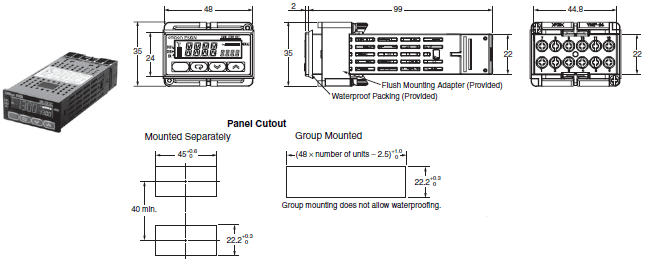
• Recommended panel thickness is 1 to 5 mm.
• Group mounting is not possible in the vertical direction. (Maintain the specified mounting space between Controllers.)
• To mount the Controller so that it is waterproof, insert the waterproof packing onto the Controller.
• When two or more Controllers are mounted, make sure that the surrounding temperature does not exceed the allowable
operating temperature specified in the specifications.
• The terminal screw for auxiliary output 2 cannot be tightened while Controllers are group mounted.
• The E58-CIFQ1 cannot be connected when the Temperature Controllers are group mounted.
E5GN-[]-C
Models with Screwless Clamp Terminal Blocks
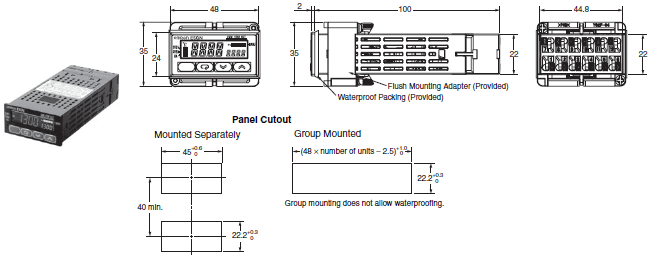
• Recommended panel thickness is 1 to 5 mm.
• Group mounting is not possible in the vertical direction. (Maintain the specified mounting space between Controllers.)
• When two or more Controllers are mounted, make sure that the surrounding temperature does not exceed the allowable
operating temperature specified in the specifications.
• The E58-CIFQ1 cannot be connected when the Temperature Controllers are group mounted.
Accessories (Order Separately)
USB-Serial Conversion Cable
E58-CIFQ1

Waterproof Packing
Y92S-32 (for DIN 48 × 24)

Order the Waterproof Packing separately if it becomes lost or damaged.
The Waterproof Packing can be used to achieve an IP66 degree of protection.
(Deterioration, shrinking, or hardening of the waterproof packing may occur depending on the operating environment. Therefore, periodic replacement is recommended to ensure the level of waterproofing specified in IP66. The time for periodic replacement depends on the operating environment. Be sure to confirm this point at your site. Consider one year a rough standard. OMRON shall not be liable for the level of water resistance if the customer does not perform periodic replacement.)
The Waterproof Packing does not need to be attached if a waterproof structure is not required.
Current Transformers
E54-CT1
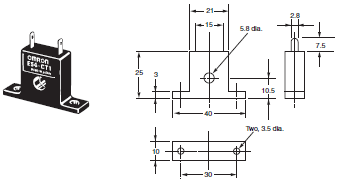
E54-CT3

E54-CT3 Accessory

E54-CT1
Thru-current (Io) vs. Output Voltage (Eo) (Reference Values)
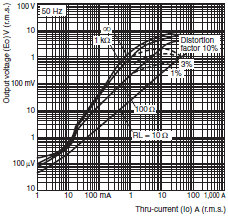
Maximum continuous heater current: 50 A (50/60 Hz)
Number of windings: 400±2
Winding resistance: 18±2 Ω
E54-CT3
Thru-current (Io) vs. Output Voltage (Eo) (Reference Values)
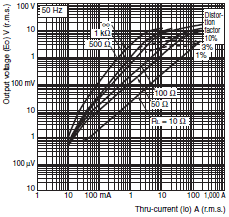
Maximum continuous heater current: 120 A (50/60 Hz)
(Maximum continuous heater current for the Temperature Controller is 50 A.)
Number of windings: 400±2
Winding resistance: 8±0.8 Ω
last update: November 12, 2012
OMRON E5GN specification
E5GN Basic-type Digital Temperature Controller (48 x 24 mm)/Specificationslast update: August 06, 2015
Ratings
| Power supply voltage | No D in model number: 100 to 240 VAC, 50/60 Hz D in model number: 24 VAC, 50/60 Hz; 24 VDC | |
|---|---|---|
| Operating voltage range | 85% to 110% of rated supply voltage | |
| Power consump- tion | E5GN Screw terminal block | 100 to 240 VAC: 5.5 VA (max.) 24 VAC/VDC: 3 VA/2 W (max.) |
| E5GN-[]-C Screwless clamp terminal block | 100 to 240 VAC: 5.5 VA (max.) 24 VAC/VDC: 3 VA/2 W (max.) | |
| Sensor input | Models with temperature inputs Thermocouple: K, J, T, E, L, U, N, R, S, B, W, or PL II Platinum resistance thermometer: Pt100 or JPt100 Infrared temperature sensor (ES1B): 10 to 70°C, 60 to 120°C, 115 to 165°C, or 140 to 260°C Voltage input: 0 to 50 mV | |
| Models with analog inputs Current input: 4 to 20 mA or 0 to 20 mA Voltage input: 1 to 5 V, 0 to 5 V, or 0 to 10 V | ||
| Input impedance | Current input: 150 Ω max., Voltage input: 1 MΩ min. (Use a 1:1 connection when connecting the ES2-HB.) | |
| Control method | ON/OFF control or 2-PID control (with auto-tuning) | |
| Control outputs | Relay output | SPST-NO, 250 VAC, 2 A (resistive load), electrical life: 100,000 operations, minimum applicable load: 5 V, 10 mA |
| Voltage output (for driving SSR) | Output voltage: 12 VDC ± 15% (PNP), max. load current: 21 mA, with short-circuit protection circuit | |
| Current output | 4 to 20 mA DC/0 to 20 mA DC, load: 500 Ω max., resolution: approx. 10,000 | |
| Auxiliary outputs | Number of outputs | 1 or 2 max. (Depends on the model.) |
| Output specifications | Relay output: SPST-NO, 250 VAC, 2 A (resistive load), electrical life: 100,000 operations, minimum applicable load: 5 V, 10 mA | |
| Event inputs | Number of inputs | 2 |
| External contact input specifications | Contact input: ON: 1 kΩ max., OFF: 100 kΩ min. | |
| Non-contact input: ON: Residual voltage: 1.5 V max., OFF: Leakage current: 0.1 mA max. | ||
| Current flow: Approx. 7 mA per contact | ||
| Setting method | Digital setting using front panel keys | |
| Indication method | 11-segment digital display and individual indicators (7-segment display also possible) Character height: PV: 7.5 mm, SV: 3.6 mm | |
| Multi SP | Up to four set points (SP0 to SP3) can be saved and selected using event inputs, key operations, or serial communications. | |
| Bank switching | Not supported | |
| Other functions | Manual output, heating/cooling control, loop burnout alarm, SP ramp, other alarm functions, heater burnout detection (including SSR failure and heater over current detection), 40% AT, 100% AT, MV limiter, input digital filter, self-tuning, temperature input shift, run/stop, protection functions, control output ON/OFF counter, extraction of square root, MV change rate limit, logic operations, PV/SV status display, simple program, automatic cooling coefficient adjustment | |
| Ambient operating temperature | -10 to 55 °C (with no condensation or icing), for 3-year warranty: -10 to 50 °C | |
| Ambient operating humidity | 25% to 85% | |
| Storage temperature | -25 to 65 °C (with no condensation or icing) | |
Input Ranges
Thermocouple/Platinum Resistance Thermometer (Universal Inputs)
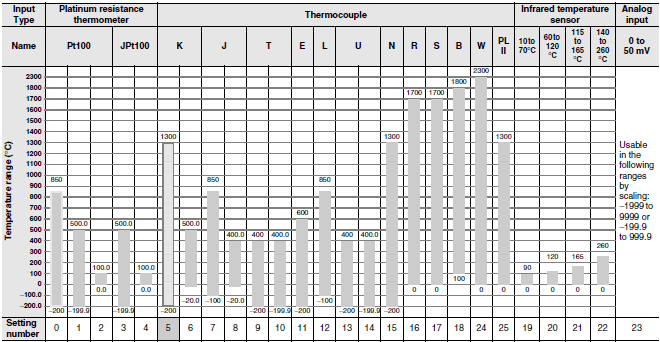
Shaded settings are the default settings.
The applicable standards for the input types are as follows:
K, J, T, E, N, R, S, B: JIS C 1602-1995, IEC 584-1
L: Fe-CuNi, DIN 43710-1985
U: Cu-CuNi, DIN 43710-1985
W: W5Re/W26Re, ASTM E988-1990
JPt100: JIS C 1604-1989, JIS C 1606-1989
Pt100: JIS C 1604-1997, IEC 751
PL II: According to Platinel II electromotive force charts from BASF (previously Engelhard)
Models with Analog Inputs
| Input Type | Current | Voltage | |||
|---|---|---|---|---|---|
| Input specification | 4 to 20 mA | 0 to 20 mA | 1 to 5 V | 0 to 5 V | 0 to 10 V |
| Setting range | Usable in the following ranges by scaling: -1999 to 9999, -199.9 to 999.9, -19.99 to 99.99 or -1.999 to 9.999 | ||||
| Setting number | 0 | 1 | 2 | 3 | 4 |
Shaded settings are the default settings.
Alarm Outputs
Each alarm can be independently set to one of the following 13 alarm types. The default is 2: Upper limit.
Auxiliary outputs are allocated for alarms. ON delays and OFF delays (0 to 999 s) can also be specified.
Note: For models with heater burnout, SSR failure, and heater overcurrent detection, alarm 1 will be an OR output of the
alarm selected from the following alarm types and the alarms for heater burnout, SSR failure, and heater
overcurrent. To output only a heater burnout alarm, SSR failure alarm, and heater overcurrent alarm for alarm 1, set
the alarm type to 0 (i.e., no alarm function).
| Set value | Alarm type | Alarm output operation | Description of function | |
|---|---|---|---|---|
| When alarm value X is positive | When alarm value X is negative | |||
| 0 | Alarm function OFF | Output OFF | No alarm | |
| 1 *1 | Upper- and lower-limit |  | *2 | Set the deviation in the set point by setting the alarm upper limit (H) and alarm lower limit (L). |
| 2 | Upper-limit |  |  | Set the upward deviation in the set point by setting the alarm value (X). |
| 3 | Lower-limit |  |  | Set the downward deviation in the set point by setting the alarm value (X). |
| 4 *1 | Upper- and lower-limit range |  | *3 | Set the deviation in the set point by setting the alarm upper limit (H) and alarm lower limit (L). |
| 5 *1 | Upper- and lower-limit with standby sequence |  *5 *5 | *4 | A standby sequence is added to the upper- and lower-limit alarm (1). *6 |
| 6 | Upper-limit with standby sequence |  |  | A standby sequence is added to the upper-limit alarm (2). *6 |
| 7 | Lower-limit with standby sequence |  |  | A standby sequence is added to the lower-limit alarm (3). *6 |
| 8 | Absolute-value upper-limit |  |  | The alarm will turn ON if the process value is larger than the alarm value (X) regardless of the set point. |
| 9 | Absolute-value lower-limit |  |  | The alarm will turn ON if the process value is smaller than the alarm value (X) regardless of the set point. |
| 10 | Absolute-value upper-limit with standby sequence |  |  | A standby sequence is added to the absolute-value upper- limit alarm (8). *6 |
| 11 | Absolute-value lower-limit with standby sequence |  |  | A standby sequence is added to the absolute-value lower-limit alarm (9). *6 |
| 12 | LBA (alarm 1 type only) | --- | Refer to Data Sheet. | |
| 13 | PV change rate alarm | --- | Refer to Data Sheet. | |
*1. With set values 1, 4 and 5, the upper and lower limit values can be set independently for each alarm type, and are
expressed as "L" and "H."
*2. Set value: 1, Upper- and lower-limit alarm

*3. Set value: 4, Upper- and lower-limit range

*4. Set value: 5, Upper- and lower-limit with standby sequence
For Upper- and Lower-Limit Alarm Described Above
• Case 1 and 2
Always OFF when the upper-limit and lower-limit hysteresis overlaps.
• Case 3: Always OFF
*5. Set value: 5, Upper- and lower-limit with standby sequence
Always OFF when the upper-limit and lower-limit hysteresis overlaps.
*6. Refer to the E5CN/E5AN/E5EN/E5GN Digital Temperature Controllers User's Manual Basic Type (Cat. No. H156) for
information on the operation of the standby sequence.
*7. Refer to the E5CN/E5AN/E5EN/E5GN Digital Temperature Controllers User's Manual Basic Type (Cat. No. H156) for
information on the loop burnout alarm (LBA).
*8. Refer to the E5CN/E5AN/E5EN/E5GN Digital Temperature Controllers User's Manual Basic Type (Cat. No. H156) for
information on the PV change rate alarm.
Characteristics
| Indication accuracy | Thermocouple: *1 (± 0.3% of indicated value or ± 1 °C, whichever is greater) ± 1 digit max. Platinum resistance thermometer input: (± 0.2% of indicated value or ± 0.8 °C, whichever is greater) ± 1 digit max. Analog input: ± 0.2% FS ± 1 digit max. CT input: ± 5% FS ± 1 digit max. | |
|---|---|---|
| Influence of temperature *2 | Thermocouple input (R, S, B, W, PL II): (± 1% of PV or ± 10 °C, whichever is greater) ± 1 digit max. Other thermocouple input: *3 (± 1% of PV or ± 4 °C, whichever is greater) ± 1 digit max. Platinum resistance thermometer input: (± 1% of PV or ± 2 °C, whichever is greater) ± 1 digit max. Analog input: (± 1%FS) ± 1 digit max. | |
| Influence of voltage *2 | ||
| Influence of EMS. (at EN 61326-1) | ||
| Input sampling period | 250 ms | |
| Hysteresis | Models with thermocouple/platinum resistance thermometer input (universal input): 0.1 to 999.9 EU (in units of 0.1 EU) *4 Models with analog input: 0.01 to 99.99% FS (in units of 0.01% FS) | |
| Proportional band (P) | Models with thermocouple/platinum resistance thermometer input (universal input): 0.1 to 999.9 EU (in units of 0.1 EU) *4 Models with analog input: 0.1 to 999.9% FS (in units of 0.1% FS) | |
| Integral time (I) | 0 to 3999 s (in units of 1 s) | |
| Derivative time (D) | 0 to 3999 s (in units of 1 s) *5 | |
| Control period | 0.5, 1 to 99 s (in units of 1 s) | |
| Manual reset value | 0.0 to 100.0% (in units of 0.1%) | |
| Alarm setting range | -1999 to 9999 (decimal point position depends on input type) | |
| Affect of signal source resistance | Thermocouple: 0.1°C/Ω max. (100 Ω max.) Platinum resistance thermometer: 0.1°C/Ω max. (10 Ω max.) | |
| Insulation resistance | 20 MΩ min. (at 500 VDC) | |
| Dielectric strength | 2,300 VAC, 50 or 60 Hz for 1 min (between terminals with different charge) | |
| Vibration resistance | Malfunction | 10 to 55 Hz, 20 2 for 10 min each in X, Y, and Z directions |
| Destruction | 10 to 55 Hz, 0.75-mm single amplitude for 2 hrs each in X, Y, and Z directions | |
| Shock resistance | Malfunction | 100 2, 3 times each in X, Y, and Z directions |
| Destruction | 300 2, 3 times each in X, Y, and Z directions | |
| Weight | Controller: Approx. 90 g, Mounting Bracket: Approx. 10 g | |
| Degree of protection | Front panel: IP66, Rear case: IP20, Terminals: IP00 | |
| Memory protection | Non-volatile memory (number of writes: 1,000,000 times) | |
| Setup Tool | CX-Thermo version 4.2 or higher | |
| Setup Tool port | Provided on the side of the E5GN. Connect this port to the computer when using the Setup Tool. An E58-CIFQ1 USB-Serial Conversion Cable is required to connect the computer to the port on the side of the E5GN. *6 | |
| Standards | Approved standards | UL 61010-1, CSA C22.2 No. 1010-1 |
| Conformed standards | EN 61010-1 (IEC 61010-1): Pollution level 2, overcurrent category II | |
| EMC | EMI: EN 61326-1 *7 Radiated Interference Electromagnetic Field Strength: EN 55011 Group 1, class A Noise Terminal Voltage: EN 55011 Group 1, class A EMS: EN 61326-1 *7 ESD Immunity: EN 61000-4-2 Electromagnetic Field Immunity: EN 61000-4-3 Burst Noise Immunity: EN 61000-4-4 Conducted Disturbance Immunity: EN 61000-4-6 Surge Immunity: EN 61000-4-5 Power Frequency Magnetic Field Immunity: EN 61000-4-8 Voltage Dip/Interrupting Immunity: EN 61000-4-11 | |
*1. The indication accuracy of K thermocouples in the −200 to 1300°C range, T and N thermocouples at a temperature of
−100°C max., and U and L thermocouples at any temperatures is ±2°C ±1 digit max. The indication accuracy of the B
thermocouple at a temperature of 400°C max. is not specified. The indication accuracy of B thermocouples in the 400
to 800°C range is ±3°C max. The indication accuracy of the R and S thermocouples at a temperature of 200°C max.
is ±3°C ±1 digit max. The indication accuracy of W thermocouples is ±0.3 of PV or ±3°C, whichever is greater, ±1
digit max. The indication accuracy of PL II thermocouples is ±0.3 of PV or ±2°C, whichever is greater, ± 1 digit max.
*2. Ambient temperature: −10°C to 23°C to 55°C, Voltage range: −15% to 10% of rated voltage
*3. K thermocouple at −100°C max.: ±10° max.
*4. “EU” stands for Engineering Unit and is used as the unit after scaling. For a temperature sensor, the EU is °C or °F.
*5. When robust tuning (RT) is ON, the differential time is 0.0 to 999.9 (in units of 0.1 s).
*6. External serial communications (RS-232C or RS-485) and cable communications for the Setup Tool can be used at
the same time.
*7. Industrial electromagnetic environment (EN/IEC 61326-1 Table 2)
USB-Serial Conversion Cable
| Applicable OS | Windows XP/Vista/7/8 |
|---|---|
| Applicable software | CX-Thermo version 4 or higher |
| Applicable models | E5AN/E5EN/E5CN/E5CN-U/E5AN-H/E5EN-H/E5CN-H/E5GN |
| USB interface standard | Conforms to USB Specification 1.1. |
| DTE speed | 38400 bps |
| Connector specifications | Computer: USB (type A plug) Temperature Controller: Setup Tool port (on bottom of Controller) |
| Power supply | Bus power (Supplied from USB host controller.) |
| Power supply voltage | 5 VDC |
| Current consumption | 70 mA |
| Ambient operating temperature | 0 to 55°C (with no condensation or icing) |
| Ambient operating humidity | 10% to 80% |
| Storage temperature | - 20 to 60°C (with no condensation or icing) |
| Storage humidity | 10% to 80% |
| Altitude | 2,000 m max. |
| Weight | Approx. 100 g |
Note: A driver must be installed in the personal computer. Refer to installation information in the operation manual for the
Conversion Cable.
Communications Specifications
| Transmission line connection method | RS-485: Multipoint RS-232C: Point-to-point |
|---|---|
| Communications | RS-485 (two-wire, half duplex), RS-232C |
| Synchronization method | Start-stop synchronization |
| Protocol | CompoWay/F, SYSWAY, or Modbus |
| Baud rate | 1200, 2400, 4800, 9600, 19200, 38400, or 57600 bps |
| Transmission code | ASCII |
| Data bit length * | 7 or 8 bits |
| Stop bit length * | 1 or 2 bits |
| Error detection | Vertical parity (none, even, odd) Frame check sequence (FCS) with SYSWAY Block check character (BCC) with CompoWay/F or CRC-16 Modbus |
| Flow control | None |
| Interface | RS-485, RS-232C |
| Retry function | None |
| Communications buffer | 217 bytes |
| Communications response wait time | 0 to 99 ms Default: 20 ms |
* The baud rate, data bit length, stop bit length, and vertical parity can be individually set using the Communications
Setting Level.
Current Transformer (Order Separately) Ratings
| Dielectric strength | 1,000 VAC for 1 min |
|---|---|
| Vibration resistance | 50 Hz, 98 m/s2 |
| Weight | E54-CT1: Approx. 11.5 g, E54-CT3: Approx. 50 g |
| Accessories (E54-CT3 only) | Armatures (2) Plugs (2) |
Heater Burnout Alarms, SSR Failure Alarms, and Heater Overcurrent Alarms
| CT input (for heater current detection) | Models with detection for single-phase heaters: One input |
|---|---|
| Maximum heater current | 50 A AC |
| Input current indication accuracy | ±5% FS ±1 digit max. |
| Heater burnout alarm setting range *1 | 0.1 to 49.9 A (in units of 0.1 A) Minimum detection ON time: 100 ms |
| SSR failure alarm setting range *2 | 0.1 to 49.9 A (in units of 0.1 A) Minimum detection OFF time: 100 ms |
| Heater overcurrent alarm setting range *3 | 0.1 to 49.9 A (in units of 0.1 A) Minimum detection ON time: 100 ms |
*1. For heater burnout alarms, the heater current will be measured when the control output is ON, and the output
assigned to the alarm 1 function will turn ON if the heater current is lower than the set value (i.e., heater burnout
detection current value).
*2. For SSR failure alarms, the heater current will be measured when the control output is OFF, and the output assigned
to the alarm 1 function will turn ON if the heater current is higher than the set value (i.e., SSR failure detection current
value).
*3. For heater overcurrent alarms, the heater current will be measured when the control output is ON, and the output
assigned to the alarm 1 function will turn ON if the heater current is higher than the set value (i.e., heater overcurrent
detection current value).
Electrical Life Expectancy Curve for Relays (Reference Values)
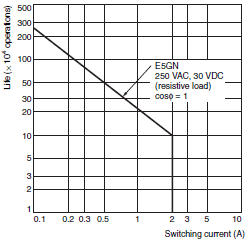
last update: August 06, 2015
OMRON E5GN catalog
E5GN Basic-type Digital Temperature Controller (48 x 24 mm)/Catalog- Catalog
- Manual
- CAD
English
Global Edition
| Catalog Name | Catalog Number [size] | Last Update | |
|---|---|---|---|
| | - [1663KB] | Mar 31, 201520150331 | E5GN Data Sheet |
| | - [1325KB] | Apr 03, 201720170403 | Safety Precautions for E5[]N, E5[]N-H, E5[]N-HT |
| | - [1526KB] | Apr 03, 201720170403 | Operation for E5[]N, E5[]N-H, E5[]N-HT |
OMRON E5GN lineup
E5GN Basic-type Digital Temperature Controller (48 x 24 mm)/Lineuplast update: October 17, 2012
Controllers with Screw Terminal Blocks
Models with Temperature Inputs
Models with One Control Output and a 100 to 240-VAC Power Supply
| Case color | Control output | Control mode *1 | No. of auxiliary outputs | Detection of heater burnout, SSR failure, and heater overcurrent | No. of event inputs | Transfer output *2 | Communi- cations | Previous model | New model | |
|---|---|---|---|---|---|---|---|---|---|---|
| Thermocou- ple input | Resistance thermome- ter input | |||||||||
| Black | Relay output | Standard | --- | --- | --- | --- | --- | E5GN-RTC | E5GN-RP | E5GN-RT |
| Standard or heating/ cooling | 1 | E5GN-R1TC | E5GN-R1P | E5GN-R1T | ||||||
| 2 | --- | --- | E5GN-R1BT | |||||||
| --- | RS-232C | --- | --- | E5GN-R101T-FLK | ||||||
| RS-485 | E5GN- R03TC-FLK | E5GN- R03P-FLK | E5GN-R103T-FLK | |||||||
| 2 | --- | --- | --- | E5GN-R2T | ||||||
| Detection for single-phase heaters | --- | --- | E5GN-R2HT | |||||||
| --- | 2 | --- | --- | E5GN-R2BT | ||||||
| --- | RS-485 | --- | --- | E5GN-R203T-FLK | ||||||
| Voltage output (for driving SSR) | Standard | --- | --- | --- | --- | --- | E5GN-QTC | E5GN-QP | E5GN-QT | |
| Standard or heating/ cooling | 1 | E5GN-Q1TC | E5GN-Q1P | E5GN-Q1T | ||||||
| 2 | --- | --- | E5GN-Q1BT | |||||||
| --- | RS-232C | --- | --- | E5GN-Q101T-FLK | ||||||
| RS-485 | E5GN- Q03TC-FLK | E5GN- Q03P-FLK | E5GN-Q103T-FLK | |||||||
| 2 | --- | --- | --- | E5GN-Q2T | ||||||
| Detection for single-phase heaters | --- | --- | E5GN-Q2HT | |||||||
| --- | 2 | --- | --- | E5GN-Q2BT | ||||||
| --- | RS-485 | --- | --- | E5GN-Q203T-FLK | ||||||
| Current output | Standard or heating/ cooling | 1 | --- | --- | Transfer output using control output | --- | --- | --- | E5GN-C1T | |
| 2 | --- | --- | E5GN-C1BT | |||||||
| --- | RS-232C | --- | --- | E5GN-C101T-FLK | ||||||
| RS-485 | --- | --- | E5GN-C103T-FLK | |||||||
*1. If heating/cooling control mode is used, an auxiliary output is used as a control output for the cooling side. The
number of auxiliary outputs that can be used will decrease by one. Also, the signal for the control output for the
cooling side will be a relay output.
*2. A current control output can be used as the transfer output. In that case, an auxiliary output is used as the control
output. (This is not possible for models without an auxiliary output.) The control output will be a relay output. The
number of auxiliary outputs that can be used will decrease by one.
Models with One Control Output and a 24-VAC/VDC Power Supply
| Case color | Control output | Control mode *1 | No. of auxiliary outputs | Detection of heater burnout, SSR failure, and heater overcurrent | No. of event inputs | Transfer output *2 | Communi- cations | Previous model | New model | |
|---|---|---|---|---|---|---|---|---|---|---|
| Thermocou- ple input | Resistance thermome- ter input | |||||||||
| Black | Relay output | Standard | --- | --- | --- | --- | --- | E5GN-RTC | E5GN-RP | E5GN-RTD |
| Standard or heating/ cooling | 1 | E5GN-R1TC | E5GN-R1P | E5GN-R1TD | ||||||
| 2 | --- | --- | E5GN-R1BTD | |||||||
| --- | RS-232C | --- | --- | E5GN-R101TD-FLK | ||||||
| RS-485 | E5GN- R03TC-FLK | E5GN- R03P-FLK | E5GN-R103TD-FLK | |||||||
| 2 | --- | --- | --- | E5GN-R2TD | ||||||
| Detection for single-phase heaters | --- | --- | E5GN-R2HTD | |||||||
| --- | 2 | --- | --- | E5GN-R2BTD | ||||||
| --- | RS-485 | --- | --- | E5GN-R203TD-FLK | ||||||
| Voltage output (for driving SSR) | Standard | --- | --- | --- | --- | --- | E5GN-QTC | E5GN-QP | E5GN-QTD | |
| Standard or heating/ cooling | 1 | E5GN-Q1TC | E5GN-Q1P | E5GN-Q1TD | ||||||
| 2 | --- | --- | E5GN-Q1BTD | |||||||
| --- | RS-232C | --- | --- | E5GN-Q101TD-FLK | ||||||
| RS-485 | E5GN- Q03TC-FLK | E5GN- Q03P-FLK | E5GN-Q103TD-FLK | |||||||
| 2 | --- | --- | --- | E5GN-Q2TD | ||||||
| Detection for single-phase heaters | --- | --- | E5GN-Q2HTD | |||||||
| --- | 2 | --- | --- | E5GN-Q2BTD | ||||||
| --- | RS-485 | --- | --- | E5GN-Q203TD-FLK | ||||||
| Current output | Standard or heating/ cooling | 1 | --- | --- | Transfer output using control output | --- | --- | --- | E5GN-C1TD | |
| 2 | --- | --- | E5GN-C1BTD | |||||||
| --- | RS-232C | --- | --- | E5GN-C101TD-FLK | ||||||
| RS-485 | --- | --- | E5GN-C103TD-FLK | |||||||
*1. If heating/cooling control mode is used, an auxiliary output is used as a control output for the cooling side. The
number of auxiliary outputs that can be used will decrease by one. Also, the signal for the control output for the
cooling side will be a relay output.
*2. A current control output can be used as the transfer output. In that case, an auxiliary output is used as the control
output. (This is not possible for models without an auxiliary output.) The control output will be a relay output. The
number of auxiliary outputs that can be used will decrease by one.
Models with Analog Inputs
Models with One Control Output and a 100 to 240-VAC Power Supply
| Case color | Control output | Control mode *1 | No. of auxiliary outputs | Detection of heater burnout, SSR failure, and heater overcurrent | No. of event inputs | Transfer output *2 | Communi- cations | Previous model | New model | |
|---|---|---|---|---|---|---|---|---|---|---|
| Thermocou- ple input | Resistance thermome- ter input | |||||||||
| Black | Relay output | Standard or heating/ cooling | 1 | --- | --- | --- | RS-485 | --- | --- | E5GN-R103L-FLK |
| Voltage output (for driving SSR) | --- | --- | E5GN-Q103L-FLK | |||||||
| Current output | Transfer output using control output | --- | --- | --- | E5GN-C1L | |||||
Note: Models with analog inputs do not display the temperature unit.
*1. If heating/cooling control mode is used, an auxiliary output is used as a control output for the cooling side. The
number of auxiliary outputs that can be used will decrease by one. Also, the signal for the control output for the
cooling side will be a relay output.
*2. A current control output can be used as the transfer output. In that case, an auxiliary output is used as the control
output. (This is not possible for models without an auxiliary output.) The control output will be a relay output. The
number of auxiliary outputs that can be used will decrease by one.
Models with One Control Output and a 24-VAC/VDC Power Supply
| Case color | Control output | Control mode *1 | No. of auxiliary outputs | Detection of heater burnout, SSR failure, and heater overcurrent | No. of event inputs | Transfer output *2 | Communi- cations | Previous model | New model | |
|---|---|---|---|---|---|---|---|---|---|---|
| Thermocou- ple input | Resistance thermome- ter input | |||||||||
| Black | Relay output | Standard or heating/ cooling | 1 | --- | --- | --- | RS-485 | --- | --- | E5GN-R103LD-FLK |
| Voltage output (for driving SSR) | --- | --- | E5GN-Q103LD-FLK | |||||||
| Current output | Transfer output using control output | --- | --- | --- | E5GN-C1LD | |||||
Note: Models with analog inputs do not display the temperature unit.
*1. If heating/cooling control mode is used, an auxiliary output is used as a control output for the cooling side. The
number of auxiliary outputs that can be used will decrease by one. Also, the signal for the control output for the
cooling side will be a relay output.
*2. A current control output can be used as the transfer output. In that case, an auxiliary output is used as the control
output. (This is not possible for models without an auxiliary output.) The control output will be a relay output. The
number of auxiliary outputs that can be used will decrease by one.
Controllers with Screwless Clamp Terminal Blocks
Models with Temperature Inputs
Models with One Control Output and a 100 to 240-VAC Power Supply
| Case color | Control output | Control mode *1 | No. of auxiliary outputs | Detection of heater burnout, SSR failure, and heater overcurrent | No. of event inputs | Transfer output *2 | Communi- cations | Previous model | New model | |
|---|---|---|---|---|---|---|---|---|---|---|
| Thermocou- ple input | Resistance thermome- ter input | |||||||||
| Black | Relay output | Standard | --- | --- | --- | --- | --- | E5GN-RTC | E5GN-RP | E5GN-RT-C |
| Standard or heating/ cooling | 1 | E5GN-R1TC | E5GN-R1P | E5GN-R1T-C | ||||||
| 2 | --- | --- | E5GN-R1BT-C | |||||||
| --- | RS-232C | --- | --- | E5GN-R101T-C-FLK | ||||||
| RS-485 | E5GN- R03TC-FLK | E5GN- R03P-FLK | E5GN-R103T-C-FLK | |||||||
| 2 | --- | --- | --- | E5GN-R2T-C | ||||||
| Detection for single-phase heaters | --- | --- | E5GN-R2HT-C | |||||||
| --- | 2 | --- | --- | E5GN-R2BT-C | ||||||
| --- | RS-485 | --- | --- | E5GN-R203T-C-FLK | ||||||
| Voltage output (for driving SSR) | Standard | --- | --- | --- | --- | --- | E5GN-QTC | E5GN-QP | E5GN-QT-C | |
| Standard or heating/ cooling | 1 | E5GN-Q1TC | E5GN-Q1P | E5GN-Q1T-C | ||||||
| 2 | --- | --- | E5GN-Q1BT-C | |||||||
| --- | RS-232C | --- | --- | E5GN-Q101T-C-FLK | ||||||
| RS-485 | E5GN- Q03TC-FLK | E5GN- Q03P-FLK | E5GN-Q103T-C-FLK | |||||||
| 2 | --- | --- | --- | E5GN-Q2T-C | ||||||
| Detection for single-phase heaters | --- | --- | E5GN-Q2HT-C | |||||||
| --- | 2 | --- | --- | E5GN-Q2BT-C | ||||||
| --- | RS-485 | --- | --- | E5GN-Q203T-C-FLK | ||||||
| Current output | Standard or heating/ cooling | 1 | --- | Transfer output using control output | --- | --- | --- | E5GN-C1T-C | ||
| 2 | --- | --- | E5GN-C1BT-C | |||||||
| --- | RS-232C | --- | --- | E5GN-C101T-C-FLK | ||||||
| RS-485 | --- | --- | E5GN-C103T-C-FLK | |||||||
*1. If heating/cooling control mode is used, an auxiliary output is used as a control output for the cooling side. The
number of auxiliary outputs that can be used will decrease by one. Also, the signal for the control output for the
cooling side will be a relay output.
*2. A current control output can be used as the transfer output. In that case, an auxiliary output is used as the control
output. (This is not possible for models without an auxiliary output.) The control output will be a relay output. The
number of auxiliary outputs that can be used will decrease by one.
Models with One Control Output and a 24-VAC/VDC Power Supply
| Case color | Control output | Control mode *1 | No. of auxiliary outputs | Detection of heater burnout, SSR failure, and heater overcurrent | No. of event inputs | Transfer output *2 | Communi- cations | Previous model | New model | |
|---|---|---|---|---|---|---|---|---|---|---|
| Thermocou- ple input | Resistance thermome- ter input | |||||||||
| Black | Relay output | Standard | --- | --- | --- | --- | --- | E5GN-RTC | E5GN-RP | E5GN-RTD-C |
| Standard or heating/ cooling | 1 | E5GN-R1TC | E5GN-R1P | E5GN-R1TD-C | ||||||
| 2 | --- | --- | E5GN-R1BTD-C | |||||||
| --- | RS-232C | --- | --- | E5GN-R101TD-C-FLK | ||||||
| RS-485 | E5GN- R03TC-FLK | E5GN- R03P-FLK | E5GN-R103TD-C-FLK | |||||||
| 2 | --- | --- | --- | E5GN-R2TD-C | ||||||
| Detection for single-phase heaters | --- | --- | E5GN-R2HTD-C | |||||||
| --- | 2 | --- | --- | E5GN-R2BTD-C | ||||||
| --- | RS-485 | --- | --- | E5GN-R203TD-C-FLK | ||||||
| Voltage output (for driving SSR) | Standard | --- | --- | --- | --- | --- | E5GN-QTC | E5GN-QP | E5GN-QTD-C | |
| Standard or heating/ cooling | 1 | E5GN-Q1TC | E5GN-Q1P | E5GN-Q1TD-C | ||||||
| 2 | --- | --- | E5GN-Q1BTD-C | |||||||
| --- | RS-232C | --- | --- | E5GN-Q101TD-C-FLK | ||||||
| RS-485 | E5GN- Q03TC-FLK | E5GN- Q03P-FLK | E5GN-Q103TD-C-FLK | |||||||
| 2 | --- | --- | --- | E5GN-Q2TD-C | ||||||
| Detection for single-phase heaters | --- | --- | E5GN-Q2HTD-C | |||||||
| --- | 2 | --- | --- | E5GN-Q2BTD-C | ||||||
| --- | RS-485 | --- | --- | E5GN-Q203TD-C-FLK | ||||||
| Current output | Standard or heating/ cooling | 1 | --- | --- | Transfer output using control output | --- | --- | --- | E5GN-C1TD-C | |
| 2 | --- | --- | E5GN-C1BTD-C | |||||||
| --- | RS-232C | --- | --- | E5GN-C101TD-C-FLK | ||||||
| RS-485 | --- | --- | E5GN-C103TD-C-FLK | |||||||
*1. If heating/cooling control mode is used, an auxiliary output is used as a control output for the cooling side. The
number of auxiliary outputs that can be used will decrease by one. Also, the signal for the control output for the
cooling side will be a relay output.
*2. A current control output can be used as the transfer output. In that case, an auxiliary output is used as the control
output. (This is not possible for models without an auxiliary output.) The control output will be a relay output. The
number of auxiliary outputs that can be used will decrease by one.
Models with Analog Inputs
Models with One Control Output and a 100 to 240-VAC Power Supply
| Case color | Control output | Control mode *1 | No. of auxiliary outputs | Detection of heater burnout, SSR failure, and heater overcurrent | No. of event inputs | Transfer output *2 | Communi- cations | Previous model | New model | |
|---|---|---|---|---|---|---|---|---|---|---|
| Thermocou- ple input | Resistance thermome- ter input | |||||||||
| Black | Current output | Standard or heating/ cooling | 1 | --- | --- | Transfer output using control output | --- | --- | --- | E5GN-C1L-C |
Note: Models with analog inputs do not display the temperature unit.
*1. If heating/cooling control mode is used, an auxiliary output is used as a control output for the cooling side. The
number of auxiliary outputs that can be used will decrease by one. Also, the signal for the control output for the
cooling side will be a relay output.
*2. A current control output can be used as the transfer output. In that case, an auxiliary output is used as the control
output. (This is not possible for models without an auxiliary output.) The control output will be a relay output. The
number of auxiliary outputs that can be used will decrease by one.
Models with One Control Output and a 24-VAC/VDC Power Supply
| Case color | Control output | Control mode *1 | No. of auxiliary outputs | Detection of heater burnout, SSR failure, and heater overcurrent | No. of event inputs | Transfer output *2 | Communi- cations | Previous model | New model | |
|---|---|---|---|---|---|---|---|---|---|---|
| Thermocou- ple input | Resistance thermome- ter input | |||||||||
| Black | Current output | Standard or heating/ cooling | 1 | --- | --- | Transfer output using control output | --- | --- | --- | E5GN-C1LD-C |
*1. If heating/cooling control mode is used, an auxiliary output is used as a control output for the cooling side. The
number of auxiliary outputs that can be used will decrease by one. Also, the signal for the control output for the
cooling side will be a relay output.
*2. A current control output can be used as the transfer output. In that case, an auxiliary output is used as the control
output. (This is not possible for models without an auxiliary output.) The control output will be a relay output. The
number of auxiliary outputs that can be used will decrease by one.
Accessories (Order Separately)
USB-Serial Conversion Cable
| Model |
|---|
| E58-CIFQ1 |
Waterproof Packing
| Model |
|---|
| Y92S-32 |
Current Transformers (CTs)
| Hole diameter | Model |
|---|---|
| 5.8 dia. | E54-CT1 |
| 12.0 dia. | E54-CT3 |
CX-Thermo Support Software
| Model |
|---|
| EST2-2C-MV4 |
Note: The E5GN is supported by CX-Thermo version 4.2 and higher.
last update: October 17, 2012
- NO. E5GN
- TYPE:Temperature Controllers General-purpose
 Copyright Statement
Copyright Statement - DATE:2021-06-11
- Associated products:
E5CS Temperature Controllers/Features E5CN-HT Programmable Temperature Controller (Digital Controller) (48 x 48 mm)/Features